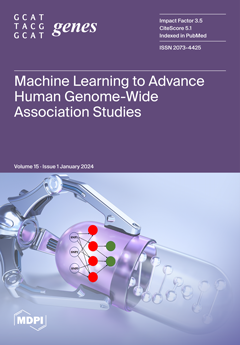Cranio-lenticulo-sutural dysplasia (CLSD, OMIM #607812) is a rare genetic condition characterized by late-closing fontanels, skeletal defects, dysmorphisms, and congenital cataracts that are caused by bi-allelic or monoallelic variants in the
SEC23A gene. Autosomal recessive inheritance (AR-CLSD) has been extensively documented in several cases
[...] Read more.
Cranio-lenticulo-sutural dysplasia (CLSD, OMIM #607812) is a rare genetic condition characterized by late-closing fontanels, skeletal defects, dysmorphisms, and congenital cataracts that are caused by bi-allelic or monoallelic variants in the
SEC23A gene. Autosomal recessive inheritance (AR-CLSD) has been extensively documented in several cases with homozygous or compound heterozygous variants in
SEC23A, whereas autosomal dominant inheritance (AD-CLSD) involving heterozygous inherited variants has been reported just in three patients. The
SEC23A gene encodes for one of the main components of a protein coat complex known as coat-protein-complex II (COPII), responsible for the generation of the envelope of the vesicles exported from the endoplasmic reticulum (ER) toward the Golgi complex (GC). AR-CLSD and AD-CLSD exhibit common features, although each form also presents distinctive and peculiar characteristics. Herein, we describe a rare case of a 10-year-old boy with a history of an anterior fontanel that closed only at the age of 9. The patient presents with short proportionate stature, low weight, and neurological impairment, including intellectual disability, global developmental delay, abnormal coordination, dystonia, and motor tics, along with dysmorphisms such as a wide anterior fontanel, hypertelorism, frontal bossing, broad nose, high-arched palate, and micrognathia. Trio clinical exome was performed, and a
de novo heterozygous missense variant in
SEC23A (p.Arg716Cys) was identified. This is the first reported case of CLSD caused by a
de novo heterozygous missense variant in
SEC23A presenting specific neurological manifestations never described before. For the first time, we have conducted a comprehensive phenotype–genotype correlation using data from our patient and the eight most well-documented cases in the literature. Our work has allowed us to identify the main specific and characteristic signs of both forms of CLSD (AR-CLSD, AD CLSD), offering valuable insights that can guide physicians in the diagnostic process. Notably, detailed descriptions of neurological features such as intellectual disability, global developmental delay, and motor impairment have not been documented before. Furthermore, our literature overview is crucial in the current landscape of CLSD due to the absence of guidelines for the clinical diagnosis and proper follow-up of these patients, especially during childhood.
Full article






